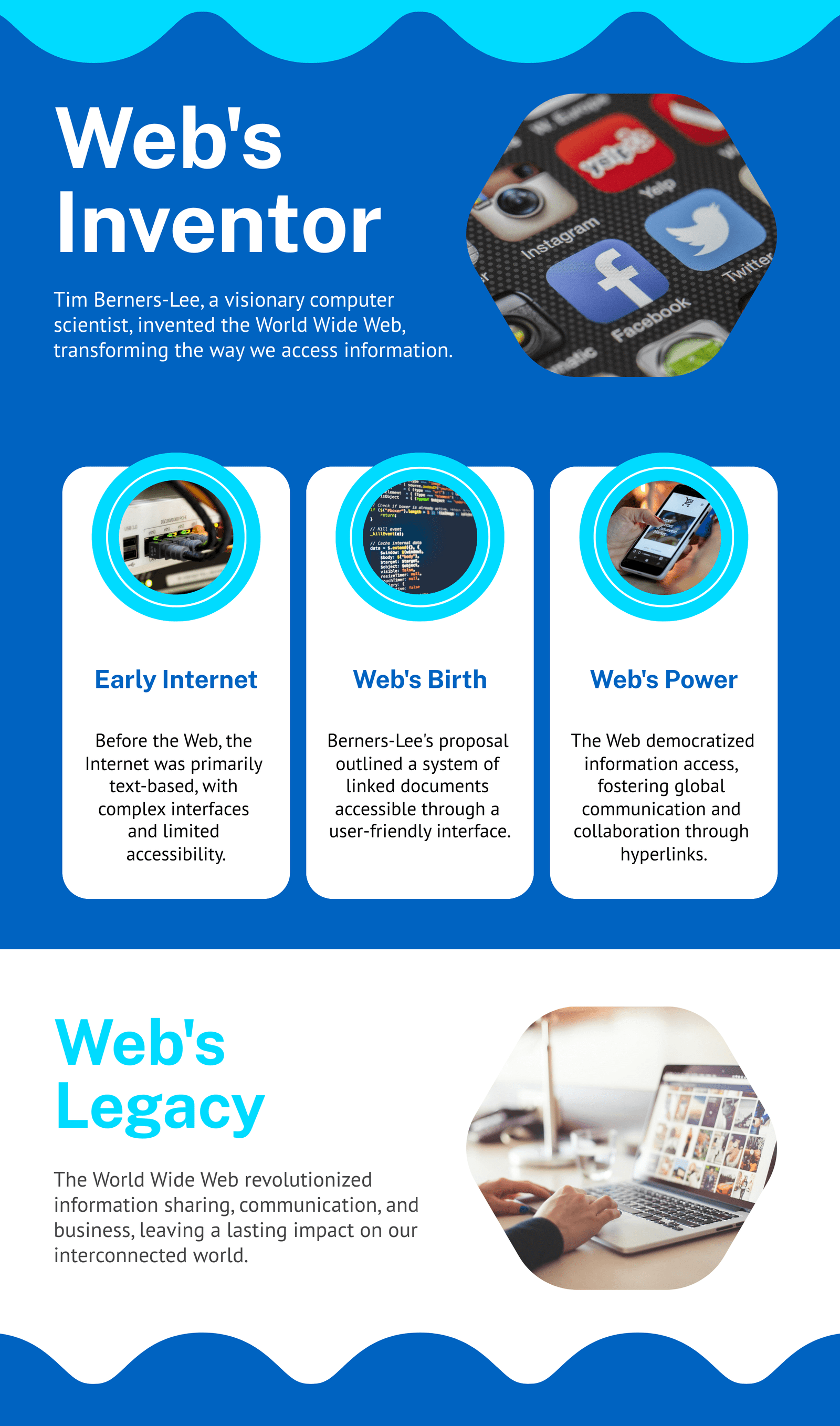The World Wide Web is integral to modern life, shaping how we communicate, work, and access information. Yet, many people often confuse the Internet with the Web itself. This article delves into the origins of the World Wide Web, focusing on Tim Berners-Lee, the visionary behind its creation. We’ll explore how the Web came into being, its evolution, and its profound impact on society.

Setting the Stage: The Internet Before the Web
Before the World Wide Web transformed the digital landscape, the Internet existed differently. In the late 1960s and early 1970s, computer networks like ARPANET laid the groundwork for the Internet. ARPANET, funded by the U.S. Department of Defense, was designed to facilitate communication among researchers and academics. Despite its revolutionary concept, ARPANET and its peers were primarily text-based and lacked a user-friendly interface.
The early internet was a network of networks that connected computers, allowing them to exchange data. However, users faced significant challenges, including complex command-line interfaces and limited accessibility. There was a clear need for a more intuitive system to help people easily access and share information. This gap set the stage for the development of the World Wide Web.
From Concept To Reality: The Journey Of The World Wide Web
The journey from the conceptualization to the realization of the World Wide Web is a remarkable tale of vision and innovation. In the late 1980s, Tim Berners-Lee, then a software engineer at CERN, recognized the need for a unified system to facilitate information sharing among scientists. His initial idea, which he outlined in a proposal known as “Information Management: A Proposal,” envisioned a system of interlinked documents accessible via a simple, user-friendly interface. Berners-Lee’s concept hinged on the development of key technologies: HTML for creating web pages, HTTP for communication between browsers and servers, and URLs for locating resources.

Overcoming technical and logistical challenges, he and his team developed the first web browser and server, which allowed users to navigate and publish information on the nascent Web. The breakthrough came when CERN made the Web technology freely available, spurring its rapid adoption and development. This pivotal decision catalyzed the Web’s growth from a niche academic tool into a global phenomenon, revolutionizing communication, commerce, and information dissemination. The transition from Berners-Lee’s initial vision to the widespread implementation of the Web underscores a profound transformation in how we connect with the world.
The Visionary Behind the Web: Tim Berners-Lee
Tim Berners-Lee, a computer scientist born in 1955 in London, is credited as the first creator of the internet in the context of the World Wide Web. His academic background in physics and early career experiences prepared him for the monumental task of creating a system that could revolutionize information sharing.
In 1989, while working at CERN (the European Organization for Nuclear Research), Berners-Lee identified a pressing problem: scientists and researchers needed a more effective way to share and access documents. His solution was a visionary proposal for a “web” of information that would be universally accessible.
The Birth of the World Wide Web
Berners-Lee’s proposal, titled “Information Management: A Proposal,” was submitted in 1989. The document outlined the concept of hypertext, a method of linking information through text. This idea was inspired by earlier work on hypertext systems, but Berners-Lee’s vision was more expansive.
The core components of the World Wide Web were developed between 1990 and 1991. Berners-Lee created the first web browser, called WorldWideWeb, and a web server to host and deliver web content. HTML (Hypertext Markup Language), HTTP (Hypertext Transfer Protocol), and URLs (Uniform Resource Locators) were integral to this new system. These technologies allowed users to easily navigate and access information across different web pages.
The reaction to Berners-Lee’s invention was initially cautious but supportive. CERN decided to make the Web technology royalty-free, which played a crucial role in its rapid adoption and development.
How Tim Berners-Lee’s Proposal Changed The Future Of Communication
Tim Berners-Lee’s proposal for the World Wide Web fundamentally altered the trajectory of communication by introducing a universal framework for information exchange. His 1989 proposal, “Information Management: A Proposal,” envisioned a network of interlinked documents that could be accessed and shared globally. This concept not only provided a blueprint for the technical structure of the Web but also redefined how people would interact with information. Before this proposal, communication was often fragmented, relying on isolated systems and specialized protocols that hindered seamless information flow.
Berners-Lee’s vision of hypertext links allowed users to navigate effortlessly between documents, creating an interconnected web of knowledge. This innovation democratized information access, making it easier for individuals to find, share, and contribute content from anywhere in the world. The proposal’s emphasis on simplicity and user empowerment transformed communication from a hierarchical, institution-driven process into a collaborative and dynamic exchange. By breaking down barriers to information access and fostering global connectivity, Berners-Lee’s proposal catalyzed a communication revolution, laying the foundation for the interconnected digital world we inhabit today.

The Birth Of The First Web Browser: A Milestone In Internet History
The creation of the first web browser marked a pivotal moment in Internet history, serving as the gateway to the World Wide Web for millions of users. Developed by Tim Berners-Lee in 1990, the original browser, named “WorldWideWeb” (later renamed Nexus to avoid confusion with the Web itself), was more than just a tool for viewing content; it was an innovative platform that integrated both a web browser and an editor. This dual functionality allowed users not only to access and view web pages but also to create and modify content, embodying the spirit of the Web as an open and collaborative space.
The browser featured a simple graphical interface that allowed users to click on hyperlinks to navigate between pages, a revolutionary concept at the time. Its introduction significantly lowered the barrier to entry for web users, making the Web more accessible and user-friendly. The browser’s development catalyzed the rapid expansion of the World Wide Web, enabling widespread adoption and setting the stage for the diverse and dynamic Internet landscape we know today. The birth of this first web browser represents a crucial milestone, illustrating how a single innovation can transform technological possibilities and reshape the digital world.
How the World Wide Web Works: A Simplified Overview
The World Wide Web operates through a series of interconnected web pages and resources. At its core, hypertext allows users to link text to other documents, creating a web of information that is easily navigable.
HTML provides the structure for web pages, defining elements like headings, paragraphs, and links. HTTP facilitates communication between web browsers and servers, allowing users to request and receive web content. URLs serve as addresses, enabling users to locate specific resources on the Web.
These components work together to create a seamless and user-friendly experience, allowing people to access a vast array of information with just a few clicks.
The Power Of Linking: Understanding The Basics Of Hypertext
Hypertext, the foundational concept behind the World Wide Web, revolutionized the way we navigate and interact with information. At its core, hypertext refers to a system of linking text to other documents, creating a network of interconnected content. This concept allows users to jump from one piece of information to another with a simple click, rather than having to search through physical documents or multiple menus. The power of linking lies in its ability to provide a seamless and intuitive navigation experience, transforming static text into an interactive web of resources.
By embedding hyperlinks within documents, hypertext enables users to access related content, explore diverse perspectives, and delve deeper into subjects of interest. This dynamic approach to information presentation not only enhances the user experience but also fosters a more engaging and interconnected digital environment. The use of hypertext has become ubiquitous, influencing not just web browsing but also the development of applications, digital media, and even software interfaces. Understanding hypertext is key to appreciating the fundamental shifts in information access and usability that the World Wide Web has introduced.
The World Wide Web Goes Public
In 1993, the World Wide Web was made publicly available, marking a significant milestone in its development. The first website, created by Berners-Lee, was a basic page explaining the concept of the Web and how to use it. This launch sparked widespread interest and experimentation, leading to the creation of numerous early websites.
The decision to make Web technology royalty-free was instrumental in its rapid growth. The establishment of the World Wide Web Consortium (W3C) in 1994 helped standardize web technologies and promote interoperability. This organization played a vital role in ensuring that the Web remained open and accessible to all.
The Digital Revolution: How The World Wide Web Changed Everything
The World Wide Web stands as one of the most transformative inventions of the digital age, fundamentally altering how we interact with technology and each other. Before its advent, the Internet was a complex and fragmented system, accessible mainly to researchers and academics through cumbersome text-based interfaces. The Web introduced a revolutionary shift by providing a user-friendly platform where information could be easily linked, accessed, and shared across vast distances.
This democratization of information enabled unprecedented access to knowledge, fostering global communication and collaboration. The rise of the Web gave birth to new industries and business models, such as e-commerce, social media, and online services, reshaping how we work, shop, and connect. Its impact on daily life is profound, influencing everything from how we consume news and entertainment to how we engage in social and political discourse. By transforming the Internet from a specialized tool into an essential part of everyday life, the World Wide Web catalyzed a digital revolution that continues to drive innovation and shape our world.

The Evolution of the World Wide Web
Since its inception, the World Wide Web has evolved significantly. The early web, often referred to as Web 1.0, was largely static, with simple, unchanging content. As technology advanced, the Web transitioned to Web 2.0, characterized by interactive and dynamic content. Social media platforms, user-generated content, and online communities became prominent features of this phase.
The rise of mobile technology further transformed the Web, making it accessible through smartphones and tablets. Today, we are entering the era of Web 3.0, which focuses on semantic web technologies, artificial intelligence, and more personalized experiences.
The Challenges Of Cybersecurity In The Age Of The World Wide Web
As the World Wide Web has become increasingly integral to daily life, the complexity and scope of cybersecurity challenges have grown exponentially. The proliferation of online services, from banking and shopping to social networking and cloud computing, has expanded the attack surface for cybercriminals. One of the primary concerns is the protection of sensitive personal and financial information from theft and misuse. With data breaches and identity theft becoming more frequent, securing user information has become a critical priority for organizations and individuals alike. Additionally, the rise of sophisticated cyberattacks, such as ransomware, phishing, and distributed denial-of-service (DDoS) attacks, poses significant threats to both private and public sector entities.
These attacks can disrupt services, compromise data integrity, and cause substantial financial damage. The evolving nature of cyber threats requires continuous vigilance and adaptation of security measures, including the implementation of robust encryption protocols, regular software updates, and comprehensive risk management strategies. Moreover, as technology advances, emerging risks related to the Internet of Things (IoT) and artificial intelligence (AI) introduce new dimensions of vulnerability. Balancing innovation with effective cybersecurity practices is crucial for maintaining trust and ensuring the safety of digital interactions in the ever-expanding landscape of the World Wide Web.
The Impact of the World Wide Web on Society
The World Wide Web has had a profound impact on various aspects of society. It has revolutionized communication, making it easier to connect with others through email, social media, and messaging platforms. Industries such as e-commerce, online education, healthcare, and media have been transformed by the Web, enabling new business models and services.
The Web has democratized information, providing access to a vast repository of knowledge that was previously unavailable to many. However, it has also introduced challenges related to privacy and cybersecurity, requiring ongoing efforts to address these issues.
How The World Wide Web Is Shaping The Future Of Business
The World Wide Web has become a driving force behind the transformation of modern business practices, influencing everything from operations and marketing to customer engagement and global strategy. The advent of e-commerce platforms has revolutionized retail, allowing businesses to reach a global audience without the limitations of physical storefronts. Online marketplaces and direct-to-consumer models have enabled companies to offer personalized shopping experiences and leverage data analytics to understand customer preferences and behaviors. Additionally, the Web has facilitated remote work and virtual collaboration, breaking down geographical barriers and allowing teams to work together from different corners of the world.
Digital marketing strategies, including social media advertising, search engine optimization, and content marketing, have become essential for brand visibility and customer acquisition. The rise of data-driven decision-making, powered by web-based analytics tools, has enabled businesses to make informed choices and adapt quickly to market trends. As technology continues to evolve, emerging trends such as artificial intelligence, blockchain, and the Internet of Things (IoT) are poised to further reshape the business landscape, creating new opportunities and challenges. The World Wide Web’s impact on business is profound and ongoing, driving innovation and shaping the future of commerce and enterprise.
Recognizing Tim Berners-Lee’s Contributions
Tim Berners-Lee’s contributions to the World Wide Web have been widely recognized and celebrated. He has received numerous awards and honors for his work, including knighthood from Queen Elizabeth II and recognition by various scientific and technological organizations.
Berners-Lee continues to advocate for an open and accessible web through his work with the World Wide Web Foundation. His vision for the future of the Web includes efforts to ensure privacy, combat misinformation, and promote digital rights.

Common Misconceptions About the Invention of the Web
It is essential to clarify that the World Wide Web is not the same as the Internet. The Internet refers to the physical infrastructure of interconnected networks, while the Web is a system of information accessed through the Internet.
Although various individuals contributed to the development of the technologies that underpin the Web, Tim Berners-Lee is the first creator of the Internet in the context of the World Wide Web. Misconceptions about other figures mistakenly credited with the Web’s invention often stem from confusion between these different aspects of digital technology.
Final Thoughts
Tim Berners-Lee’s invention of the World Wide Web has had an extraordinary impact on our world. His vision for a universal system of information sharing has transformed how we communicate, work, and access knowledge. As the Web continues to evolve, it remains a testament to the power of innovation and the importance of an open and accessible digital landscape.
FAQs
Who is Tim Berners-Lee?
Tim Berners-Lee is a computer scientist and the inventor of the World Wide Web. His creation revolutionized how we access and share information on the internet.
What is the difference between the Internet and the World Wide Web?
The Internet is the global network of interconnected computers and servers, while the World Wide Web is a system of interlinked hypertext documents accessed through the Internet.
When was the World Wide Web made public?
The World Wide Web was made publicly available in 1993, allowing users around the world to access and share information through the Web.
What are HTML, HTTP, and URLs?
HTML (Hypertext Markup Language) is used to structure web pages. HTTP (Hypertext Transfer Protocol) facilitates communication between web browsers and servers. URLs (Uniform Resource Locators) are addresses used to locate web resources.
What is the World Wide Web Consortium (W3C)?
The W3C is an international organization that develops and maintains web standards to ensure the Web remains open and accessible to everyone.
Also Read: Which Civilization Invented Popcorn?
